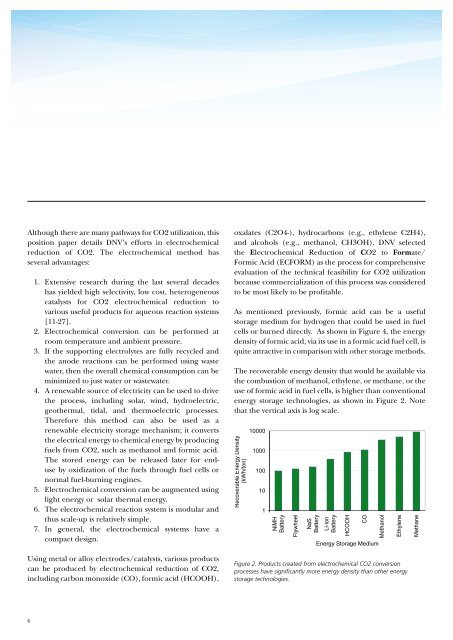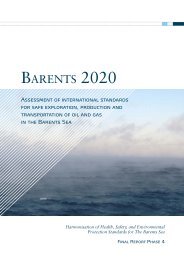Carbon Dioxide Utilization - DNV
Carbon Dioxide Utilization - DNV
Carbon Dioxide Utilization - DNV
Create successful ePaper yourself
Turn your PDF publications into a flip-book with our unique Google optimized e-Paper software.
Although there are many pathways for CO2 utilization, thisposition paper details <strong>DNV</strong>’s efforts in electrochemicalreduction of CO2. The electrochemical method hasseveral advantages:1. Extensive research during the last several decadeshas yielded high selectivity, low cost, heterogeneouscatalysts for CO2 electrochemical reduction tovarious useful products for aqueous reaction systems[11-27].2. Electrochemical conversion can be performed atroom temperature and ambient pressure.3. If the supporting electrolytes are fully recycled andthe anode reactions can be performed using wastewater, then the overall chemical consumption can beminimized to just water or wastewater.4. A renewable source of electricity can be used to drivethe process, including solar, wind, hydroelectric,geothermal, tidal, and thermoelectric processes.Therefore this method can also be used as arenewable electricity storage mechanism; it convertsthe electrical energy to chemical energy by producingfuels from CO2, such as methanol and formic acid.The stored energy can be released later for enduseby oxidization of the fuels through fuel cells ornormal fuel-burning engines.5. Electrochemical conversion can be augmented usinglight energy or solar thermal energy.6. The electrochemical reaction system is modular andthus scale-up is relatively simple.7. In general, the electrochemical systems have acompact design.Using metal or alloy electrodes/catalysts, various productscan be produced by electrochemical reduction of CO2,including carbon monoxide (CO), formic acid (HCOOH),oxalates (C2O4-), hydrocarbons (e.g., ethylene C2H4),and alcohols (e.g., methanol, CH3OH). <strong>DNV</strong> selectedthe Electrochemical Reduction of CO2 to Formate/Formic Acid (ECFORM) as the process for comprehensiveevaluation of the technical feasibility for CO2 utilizationbecause commercialization of this process was consideredto be most likely to be profitable.As mentioned previously, formic acid can be a usefulstorage medium for hydrogen that could be used in fuelcells or burned directly. As shown in Figure 4, the energydensity of formic acid, via its use in a formic acid fuel cell, isquite attractive in comparison with other storage methods.The recoverable energy density that would be available viathe combustion of methanol, ethylene, or methane, or theuse of formic acid in fuel cells, is higher than conventionalenergy storage technologies, as shown in Figure 2. Notethat the vertical axis is log scale.Figure 2. Products created from electrochemical CO2 conversionprocesses have significantly more energy density than other energystorage technologies.6





![Risk Based Pipeline Integrity Management [Compatibility Mode] - DNV](https://img.yumpu.com/50424229/1/190x146/risk-based-pipeline-integrity-management-compatibility-mode-dnv.jpg?quality=85)










